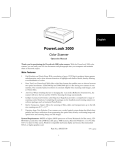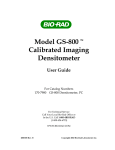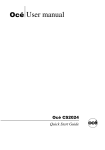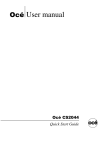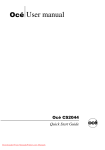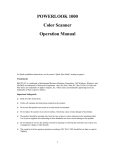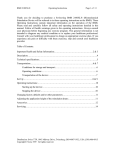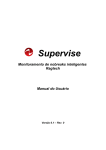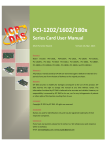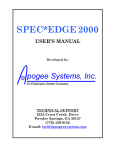Download UMAX Technologies PowerLook PowerLook III Specifications
Transcript
PowerLook 2100XL Operation Manual Thank you for purchasing the PowerLook 2100XL color scanner. With PowerLook 2100XL color scanner, you can easily scan documents and photographs into your computer and maintain them as electronic copies. Main Features: High Resolution and Density Range: With a resolution of up to 9600 dpi and high density range, it produces better gamma transformation, and more accurate detection of highlight and shadow details, thereby allowing even distribution of colors. High Scanning Speed, Low Acoustic Noise: The scanner’s micro stepping technology greatly increases scanning speed and at the same time reduces noise level. Intelligent Scanning Control Interface called MagicScan: MagicScan provides a comprehensive range of scanning control functions. Completing the package are the bundled award-winning and proven software packages such as binuscan PhotoPerfect. Transparency Adapter: Allows the scanning films, slides and transparencies up to the full-size scanning area: 12” x 17”. Proprietary Image Noise Reduction: Your scanner uses a sealed optical system design that blocks dust particles and excess reflections from penetrating the optical unit, thereby overcoming image and optical noise and ensuring sharp, true-life images. System Requirements: For PC users: Pentium or higher, CD-ROM drive, hard drive with 50 MB free disk space, 64MB memory, Microsoft Windows 95, 98, NT 4.0, Windows 2000, Windows-compatible keyboard, display, and mouse. Recommended: SVGA or higher graphics card. For Mac users: Power Macintosh, New Power Mac G3, G4, CD-ROM drive, hard drive with 50MB free disk space, 64MB memory, Mac OS 8.5 or later. Trademarks IBM, PC/AT and PS/2 are trademarks of International Business Machines Corporation. MS-Windows are trademarks of Microsoft Corporation. Apple, Macintosh, Power Macintosh are registered trademarks of Apple Computer, Inc. Other trademarks and brand names mentioned in this documentation are trademark properties of their respective holders. 1 Contents Quick Start Guide…………………………………………………………………………………………...3 1. Unpack your Scanner……………………………………………………………………………….3 2. Connect the Interface Card………………………………………………………………………….3 3. Connect the SCSI Cable…………………………………………………………………………….3 4. Connect the Power………………………………………………………………………………….3 5. Power Up……………………………………………………………………………………………4 6. Software Installation………………………………………………………………………………..4 About this manual………………………………………………………………………………………..5 Chapter 1: Getting Started………………………………………………………………………………...6 Before You Begin………………………………………………………………………………………..6 Unpack Your Scanner…………………………………………………………………………………………6 Static Electricity Precautions………………………………………………………………………………..6 A Glance at Your Scanner……………………………………………………………………………….6 Prepare the Scanner……………………………………………………………………………………...8 Test the Scanner……………………………………………………………………………………………….8 Changing the SCSI ID Number……………………………………………………………………………...8 Care and Maintenance Tips……………………………………………………………………………...9 Chapter 2: Macintosh Installation……………………………………………………………………….10 Interface Card Installation……………………………………………………………………………...10 Connect the Scanner to your Computer………………………………………………………………..10 Installing the Software………………………………………………………………………………….11 How to Scan with Scan Frames………………………………………………………………………...12 Multiple Scanning Using the A3/ 35mm Slide Tray……………………………………………………..13 Chapter 3: PC Installation………………………………………………………………………………..14 Interface Card Installation……………………………………………………………………………...14 Connect the Scanner to the Computer………………………………………………………………….14 Installing the Software………………………………………………………………………………….15 How to Scan with Scan Frames………………………………………………………………………...16 Multiple Scanning Using the A3/ 35mm Slide Tray……………………………………………………..17 Chapter 4: Troubleshooting Tips………………………………………………………………………...18 General Approach………………………………………………………………………………………18 LED Indicators…………………………………………………………………………………………19 Appendix A: Installing A SCSI Card…………………………………………………………………….20 Check the SCSI ID…………………………………………………………………………………………...20 Reset the Address of the Scanner…………………………………………………………………………..20 Checking the Terminators…………………………………………………………………………………..21 Installing the software and SCSI card driver…………………………………………………………….22 Connect the Computer and Scanner……………………………………………………………………….23 Appendix B: Scanner Specifications……………………………………………………………………..24 Glossary…………………………………………………………………………………………………….25 2 Quick Start Guide This section serves as a quick reference to the connection and installation procedures for the PowerLook 2100XL scanner. 1. Unpack your Scanner Unpack your scanner. Make sure that all the scanner system hardware, software, cabling, and documentation items indicated on the packing list are present. 2. Connect the Interface Card a) For PC users, turn off your computer and remove the computer’s housing cover. b) For New Power Mac G3 and G4 users, turn off your computer and open the side lid of your computer. c) Locate an available slot. d) Insert the SCSI card by pressing it gently but firmly into the slot. Make sure it is firmly seated in the slot and firmly tighten the screw (as shown in the figures below). For PC Users For New Power Mac G3, G4 users 3. Connect the SCSI Cable Connect the SCSI cable to the SCSI interface card and the other end of the SCSI cable to the scanner. For stable SCSI connection, setting terminator is required. Please refer to Appendix A for more details on setting termination. 4. Connect the Power Connect the power cord to the scanner and plug the other end of the power cord into an available outlet (socket). 3 5. Power Up a) Turn the scanner power switch on. When the Ready indicator is on, your scanner is ready to use. b) Turn on your computer 6. Software Installation We recommend that you install your image editing software first and then MagicScan. a) Insert UMAX MagicScan CD into your CD-ROM drive. b) Follow the on-screen instructions to completely install MagicScan. Notes: If installation program does not show up automatically, please follow the procedure to install: Mac: Double-click “MagicScan installer” icon. PC: Choose RUN from Start menu and type d:\setup (where “d” indicates CD-ROM drive), then click OK. If needed, after MagicScan installation, you could install binuscan PhotoPerfect. 4 About this manual This manual is divided into chapters and appendices. The chapters give instructions on all aspects of installation, troubleshooting, and basic scanner maintenance. The appendices contain relevant technical information for your reference. Chapter 1 Gives instructions on scanner preparation and tips on handling and routine scanner maintenance. Chapter 2 Gives instructions on scanner connection to a Macintosh computer and the corresponding software installation. Chapter 3 Gives instructions on scanner connection to an IBM PC compatible and the corresponding software installation. Chapter 4 Gives troubleshooting tips for possible problems with the scanner. Appendix A Gives instructions for installing a PCI-compatible interface card. Appendix B List specifications for PowerLook 2100XL. A Glossary and an Index are also included for easy reference. 5 Chapter 1: Getting Started Your PowerLook 2100XL scanner is extremely user-friendly. Hardware and software installation can be completed in a few steps. In minutes you can start operating your scanner to see for yourself the kind of quality scanned images it can produce. This chapter tells you how to prepare your scanner for connection and installation. It also gives some handling precautions and general care measures to ensure that your scanner will stay in top condition at all times. Before You Begin Unpack Your Scanner Ensure that your package contains all the hardware, software, cabling, ad documentation you ordered. Check for any damage that may have occurred while the package was in transit. If there are any missing or damaged items in your scanner package, contact your dealer or the carrier of your package immediately. Static Electricity Precautions Static electricity (in your body) can cause damage to the electronic components of the scanner’s printed circuit board or the computer’s interface card. Therefore, you need to discharge static build-up from your body before handling any card or component outside of its anti-static packaging. To protect your equipment from static discharge, you are advised to closely follow these measures below: • Discharge any static build-up in your body by touching a grounded or anti-static surface (such as a large metal object or the silver-toned expansion slot covers at the rear of your computer). Do this prior to removing any electronic components from their anti-static bags. • When handling any electronic components, avoid touching any metal part of the component such as the gold “fingers” that plug into the expansion slot. It is best to handle system components either by their edges or by their mounting brackets. A Glance at Your Scanner Take a few minutes to become familiar with the different parts of the scanner. The figure below shows the locations and names of the scanner parts. A brief description of each part is also given. Object Glass – The glass surface on which the document or image for scanning is placed; made of tempered glass with excellent optical qualities. Document Cover – The plastic cover over the object glass. Can be raised or lowered to cover a document. LED Indicators – Two indicators – Power and Ready Power Switch – Used for turning the scanner power ON and OFF. SCSI ID Switch – Used for setting the scanner’s SCSI ID. 6 25/50-Pin SCSI Connector – Where you plug in the 25/50-Pin SCSI cable. UTA Connector – A connector used to connect the optional UMAX Transparency Adapter. Power Cord Connector – Where you plug in the scanner power cord. Front View Rear View 7 Prepare the Scanner Prepare your scanner for installation through the following simple steps: Check and reset (if necessary) the scanner’s SCSI ID Run the automatic scanner self-test Test the Scanner The scanner automatically performs a simple self-test each time it is turned on. This self-test checks the status of certain scanner devices. Start the scanner self-test by following the steps below: 1. Connect the power cord to a wall outlet. 2. Connect the other end of the power cord to the scanner. 3. Turn on the power of the scanner. At power-on, the front panel indicators flash once. The power indicator then glows and the ready indicator blinks. When the test is completed, the power and ready indicators glow steadily. Changing the SCSI ID Number Your scanner’s SCSI ID setting is factory preset at #6. Check to see if this ID setting is used by another device connected to your computer’s SCSI port. If SCSI ID #6 is not used, you do not need to change your scanner’s SCSI ID number. You can directly proceed to hardware connection and software installation. For installation instructions, proceed to Chapter 2 if you are connecting to a Macintosh computer or to Chapter 3 if you are connecting to an IBM PC. If you find however, that another connected device is already using SCSI ID #6, then you must reset the SCSI ID on your scanner. 8 To reset the SCSI ID, do the following: 1. Make sure the scanner power is off. 2. Use a screwdriver to rotate the SCSI ID switch on the SCSI ID switch until an unused number appears in the switch’s notch. Note: Do not use SCSI ID setting from 7 through 9 on your scanner. They are for factory use only. Care and Maintenance Tips Regularly clean the object glass of the scanner and the transparency adapter to prevent dirt or smudge build-up that may reduce the quality of your scanned images. Before you clean the object glass, make sure the scanner power is off and the power cord is unplugged. Clean the object glass of the scanner and the transparency adapter with a soft damp cloth and a mild detergent or alcohol. Note: Avoid spraying cleaning fluid directly on the object glass. This may cause the liquid to penetrate the seams around the glass and contaminate the mirrors and lenses inside the scanner. Spray the liquid on the cleaning cloth then wipe the glass clean. Be sure that nothing covers the calibration area. It is important to keep the calibration area clean since dust or smudge marks on the glass will reduce the quality of scanned transparencies. Make sure the transparency fits in the scanning area. Do not leave transparencies on the object glass of the scanner for excessive periods of time. The warmth of the scanner and transparency adapter lamps may cause them to deteriorate. Please, use the Frame holder to secure the transparencies for scanning. 9 Chapter 2: Macintosh Installation This chapter describes how you can use your scanner with your Macintosh computer. Interface Card Installation (For Mac with built in SCSI port users, please skip to next section) Before you can use your scanner with your computer, you need to install the interface card into your Computer. To install the card into one of the computer’s expansion slots, observe the following procedures: Note: The interface card is sensitive to static electricity. Handle the card by its mounting bracket, particularly when removing the card from its anti-static packaging. 1. Turn the computer power off and unplug the power cord. 2. Remove the housing cover of the computer. Follow the instructions provided in your Computer’s reference manual. 3. Remove the metal cover corresponding to your chosen slot. Keep the removed screw so that it can be used to fasten the interface card. 4. Gently insert the interface card into the slot until it is firmly seated in the slot. 5. Secure the card in place with the screw removed from the expansion slot cover in step 3 above. 6. Replace the housing cover following the instructions provided in the computer’s reference manual. Connect the Scanner to your Computer 1. Ensure that the scanner’s SCSI ID is properly set. Refer to the “Changing the SCSI ID Number” section in Chapter 1 for instructions on setting the scanner’s SCSI ID. 2. Turn on Active terminator and termination power (please refer to Appendix A for more details on setting termination), connect the SCSI cable to SCSI port and connect the other end of he SCSI cable to the scanner. 10 3. Connect the power cord to the scanner. And connect the other end of the power cord to a grounded power socket. 4. Turn on the scanner power. 5. Turn on the computer power. Installing the Software Install the software in the following order: 1. Image Application Software, e.g. Adobe Photoshop. 2. Insert UMAX MagicScan CD into your CD-ROM drive. 3. Follow the on-screen instructions to completely install MagicScan. Note: If installation does not show up automatically, please follow the procedure to install: Double-click “MagicScan Installer” icon. Double-click the Read Me icon in the MagicScan group for important up-to-date information that may not be included in the manual. If there are any problems with the icons in MagicScan group, double-click the Help icon in the MagicScan group. 4. If needed, after MagicScan installation, you could install binuscan Photoperfect. MagicScan is the interface used by application software to control UMAX scanners. Its advanced controls allow precise adjustments in images even during the initial scan. For detailed information on installing the software, refer to the Installation section of the Image Application Software User’s Guide and MagicScan Electronic Books. 11 How to Scan with Scan Frames Scan Frames are for use with transparencies and negatives. Scan Frames are thin, hinged rectangular-shaped plastic frames (see following diagrams) which can hold a source document of a slightly smaller size. The Scan Frames come in a number of sizes. Orientation holes are located on the short sides of the frames. When one or more of these frames are placed on the scanner’s object glass and the “Scan” button is clicked, the scanner will automatically detect the existence of each frame by using the orientation holes for reference and will only include what is within each Scan Frame in the resulting scanned image. To use the Scan Frames, do the following: 1. Ensure the Transparency Adapter is fitted before proceeding with the scan. 2. Open the Scan Frame and place the source document inside, taking care not to cover the orientation holes. 3. Lift up the Scanner’s transparency adapter and place the Scan Frame on the scanner’s object glass. 4. Carefully align the Scan Frame so that it’s exactly parallel with one of the rulers bordering the scanner’s object glass. You can easily do this by simply placing the Scan Frame against one of the rulers. Note: Although misalignment will not prevent the scanner from scanning, portions of the Scan Frame may appear in the resulting scan if the frame is not perfectly aligned. 5. Choose “Transparent” option from the MagicScan. For detailed information on using frame holders, refer to your MagicScan online help. 6. Also, you can select the “Frame Holder” option from the MagicScan and click the “Preview” button. MagicScan will auto detect the frame holder and scan the image inside it precisely. 12 Multiple Scanning Using the A3/ 35mm Slide Tray 1. Place the transparencies into the slide holders on the slide tray. 2. Lift up the A3 Scanner’s transparency adapter and place the Slide Tray on the scanner’s object glass. 3. Line the orientation holes up in such a way that the entire tray fits on the object glass and the slide tray borders line up with the rulers on the scanner’s object glass. Note: Although misalignment will not prevent the scanner from scanning, portions of the Slide Tray may appear in the resulting scan if the frame is not perfectly aligned. 4. Repeat steps 1 through 3 for placement of additional slides. 5. In addition, you must select the “35mm Slide Tray” option from the MagicScan. 6. Click the “Preview” button. MagicScan will auto detect the slide tray and scan the image inside it precisely. Note: Do not open the document cover while scanning an image. Otherwise, the scanning image quality might be poor. 13 Chapter 3: PC Installation This chapter describes how you can connect and use the PowerLook 2100XL scanner with your IBM PC or compatible computer. Interface Card Installation Before you can use your scanner with your computer, you need to install the interface card into your PC. To install the card into one of the computer’s expansion slots, observe the following procedures: Note: The interface card is sensitive to static electricity. Handle the card by its mounting bracket, particularly when removing the card from its anti-static packaging. 1. Turn the computer power off and unplug the power cord. 2. Remove the housing cover of the computer. Follow the instructions provided in your PC’s reference manual. 3. Remove the metal cover corresponding to your chosen slot. Keep the removed screw so that it can be used to fasten the interface card. 4. Gently insert the interface card into the slot until it is firmly seated in the slot. 5. Secure the card in place with the screw removed from the expansion slot cover in step 3 above. 6. Replace the housing cover following the instructions provided in the computer’s reference manual. Connect the Scanner to the Computer With settings on the scanner and card correctly set and the interface card properly installed in your computer, you can now connect the scanner and the computer, as follows: 1. Connect the 25-pin cable connector to the interface card in the PC. 2. Turn on Active terminator and termination power (please refer to Appendix A for more details on setting termination), connect the SCSI cable to SCSI port and connect the other end of the SCSI cable to the scanner. 14 3. Connect the power cord to the scanner. 4. Turn on the scanner power. 5. Turn on the computer power. Hardware installation is now completed. Get ready to run the UMAX Setup program to install the supporting UMAX software supplied with your system. Installing the Software Install the software in two easy steps, in the following order: 1. Image Application Software, e.g. binuscan PhotoPerfect, Adobe PhotoShop. 2. Insert UMAX MagicScan CD into your CD-ROM drive. 3. Follow the on-screen instructions to completely install MagicScan. Note: If installation program does not show up automatically, please follow the procedure to install: Choose RUN from Start menu and type d:\setup (where “d” indicates CD-ROM drive), then click OK. Double-click the Read Me icon in the MagicScan group for important up-to-date information that may not be included in the manual. If there are any problems with the icons in MagicScan group, double-click the Help icon in the MagicScan group. 4. If needed, after MagicScan installation, you could install binuscan PhotoPerfect. MagicScan is the interface used by application software to control UMAX scanners. Its advanced controls allow precise adjustments in images even during the initial scan. For detailed information on installing the image editing application software, refer to the Installation section of the Image Editing Application Software User’s Guide. 15 How to Scan with Scan Frames Scan Frames are for use with transparencies and negatives. Scan Frames are thin, hinged, rectangular-shaped plastic frames (see following diagrams) which can hold a source document of a slightly smaller size. The Scan Frames come in a number of sizes, including 35mm, 120mm, 6 x 6 cm and, 4 x 5 inch. Orientation holes are located on the short sides of the frames. When one or more of these frames are placed on the scanner’s object glass and the “Scan” button is clicked, the scanner will automatically detect the existence of each frame, using the orientation holes for reference, and will only include what is within each Scan Frame in the resulting scanned image. To use the Scan Frames, do the following: 1. Ensure the Transparency Adapter is fitted before proceeding with the scan. 2. Open the Scan Frame and place the source document inside, taking care not to cover the orientation holes. 3. Lift up the Scanner transparency adapter and place the Scan Frame on the scanner’s object glass. 4. Carefully align the Scan Frame so that it’s exactly parallel with one of the rulers bordering the scanner’s object glass. You can easily do this by simply placing the Scan Frame against one of the rulers. Note: Although misalignment will not prevent the scanner from scanning, portions of the Scan Frame may appear in the resulting scan if the frame is not perfectly aligned. 5. Choose “Transparent” option from the MagicScan. For detailed information on using frame holders, refer to your MagicScan online help. 6. Also, you can select the “Frame Holder” option from the MagicScan. And click the “Preview” button. MagicScan will auto detect the frame holder and scan the image inside it precisely. 16 Multiple Scanning Using the A3/ 35mm Slide Tray 1. Place the transparencies into the slide holders on the slide tray. 2. Lift up the A3 Scanner’s transparency adapter and place the Slide Tray on the scanner’s object glass. 3. Line the orientation holes up in such a way that the entire tray its on to the object glass and the slide tray borders lines up with the rulers on the scanner’s object glass. Note: Although misalignment will not prevent the scanner from scanning, portions of the Slide Tray may appear in the resulting scan if the frame is not perfectly aligned. 4. Repeat steps 1 through 3 for placement of additional slides. 5. In addition, you must select the “35mm Slide Tray” option from the MagicScan. 6. Click the “Preview” button. MagicScan will auto detect the slide tray and scan the image inside it precisely. Note: Do not open the document cover while scanning an image. Otherwise, the scanning image quality might be poor. 17 Chapter 4: Troubleshooting Tips The PowerLook 2100XL scanner was designed to provide a hassle-free installation and operation. However, should you encounter problems with your scanner, correct them by way of the troubleshooting tips given in this chapter. For persistent problems with your computer, consult your dealer or approved service personnel. General Approach In most cases, a problem does not call for the service of a qualified technician. The solution may be very simple, such as correcting cabling connections and the like. The solution of a problem normally lies at the source of the problem. Therefore, it is important that you ascertain the cause of the failure or malfunction. Below is a general troubleshooting approach. 1. Check the connections and installation. Ensure that there are no loose connections. Ensure that the settings on the scanner and/or the interface card are correct. 2. Check the error messages appearing on the screen. Does the message point to a hardware problem or software problem? If the problem is software-related, refer to the software reference manuals or on-line help. Most software manuals include a troubleshooting chapter. If the problem is hardware-related, verify that the cause is from your computer or scanner or in some cases, your network. If it is due to your computer malfunctioning, then consult your computer’s reference manuals or a computer service technician. Note: Macintosh and IBM computers and compatibles display error messages that normally tell you the cause of the problem and in some cases tell you what to check or do to solve the problem. 3. If the error message points to a problem with your scanner system, run the scanner self-test. Turn the power of your scanner on. At power on, your scanner automatically runs the scanner self-test which can detect most of the problems with your scanner. Observe the behavior of the LED indicators. Record all your observations. 4. If all else fails, call your dealer. To facilitate servicing, supply your dealer with the following information: • Your host environment files such as your config.sys, autoexec.bat, win.ini, system.ini, and other system files. For Mac users, use Apple system profiler located at Apple menu item to output the system environment file. • Names and version of the application software you are using. • Model and version of other SCSI devices card you are using. • TWAIN / plug-in, computer model version. • Names and version of your scanner hardware. • Error codes or messages seen. 18 • Description of what you were doing at the time the malfunction or failure occurred. • Description of what you did to attempt to solve the problem. • Other observations that may aid the technician in identifying the problem and the solution. LED Indicators Listed below are some of the more common specific problems you may have with your scanner. Corrective actions are also given. Problem 1: Power Indicator fails to come on Possible Cause / Solution: • Make sure the power cable is plugged into the scanner and the wall socket. • Make sure that the power switch is on. • If none of the above works, contact your dealer. Problem 2: Scanner lamp flickers, is dim, or fails to come on Possible Cause / Solution: • The scanning lamp is failing or has failed and needs to be changed. Contact your dealer. Problem 3: If the Power and Ready indicators come on, but software returns “Scanner link failed” or similar message Possible Cause / Solution • Make sure the cable is connected properly. • Verify the setting of the SCSI ID number. • Disconnect all SCSI devices and connect them one by one, beginning with the scanner, to identify the device causing the problem. • Check the terminators and the cables. If the problem persists, contact your dealer. 19 Appendix A: Installing A SCSI Card If you are using a SCSI interface card with your computer and scanner, refer to the installation instructions provided with the interface card. After installing the card, do the following steps before connecting your scanner to your computer: • Confirm or reset the SCSI ID of the scanner. • Check the terminators in the SCSI Chain. • Make the SCSI cable connections. Check the SCSI ID The illustration below shows the location of the SCSI ID selector at the rear panel of the scanner. The selector shows the SCSI ID setting of the scanner. In this case, it is #6 – the factory preset address. After installing a SCSI interface card in your computer, proceed with the following: 1. Check the SCSI ID of all devices on the SCSI chain. Is SCSI ID #6 on the list of SCSI ID in use? 2. If not, then you can connect your computer to the scanner with a factory preset SCSI ID of 6. You may jump to the section Check the Terminators in this appendix. Reset the Address of the Scanner If the SCSI ID #6 is in the list of SCSI ID in use, then you must reset the SCSI ID selector to another number: 1. Ensure the scanner power is off. 2. Choose any unused number in the range 1-6. Note: Do not use setting 7 to 9 on your scanner. They are for factory use only. 3. Reset the scanner’s SCSI ID to the number you have chosen. 20 Checking the Terminators There should be two terminators in a SCSI chain: it is best to place the terminators at each end of the SCSI chain. PowerLook 2100XL has a built-in active terminator switch for you to turn on and off (see the illustration). Number 1 represents “active terminator” and number 2 represents “terminator power”. Turning both the “active terminator” and “terminator power” switch on by pressing them down will enable the built-in “active terminator” function. In this situation, the card will have a built-in terminator. The card forms one end of the SCSI chain; the scanner forms the other end. Turn on the “active terminator” and “terminator power” switch by pressing them down to enable the built-in “active terminator” function. These will ensure that there are two terminators and that they are placed at the ends of the SCSI chain. The simplest configurations for using the scanner with a SCSI card are as follows: Case 1: Connect the scanner to an interface card that does not have another SCSI device attached to it. e.g. Scanner is the only SCSI device connected to your computer. In this situation, the card will have a built-in terminator. The card forms one end of the SCSI chain, the scanner forms the other end. Simply turning on the active terminator of your scanner. 21 Case 2: Connect the scanner to a SCSI card that has another SCSI device attached to it. Case 3: Scanner is the last SCSI device in the SCSI Chain. The setting of active terminator is the same with Case 1. Simply turning on the active terminator of your scanner. Installing the software and SCSI card driver After connecting the interface card, the next step is to install the software. Depending on which SCSI interface card you chose to connect, there are tow cases for you to follow. Case 1: If the SCSI interface card is the one bundled by UMAX, install software in the following order. 1. Image Application Software. 2. Then MagicScan. MagicScan will find and install the SCSI interface card driver automatically. Case 2: If the SCSI interface card you installed is not the one bundled by UMAX, install software in the following order. 1. Install SCSI interface card driver first, please refer to the SCSI interface card installation instructions to install the card driver. 2. Image Application Software. 3. And then MagicScan. 22 Connect the Computer and Scanner Now that the interface card has been installed and all of the settings on the scanner and card are properly set, you can connect the computer and the scanner. Once this has been done, the hardware installation will be complete. To connect the scanner and computer, do the following: 1. Connect the SCSI cable to the interface card. 2. Connect the other end of the SCSI cable to the scanner. 3. Connect the power cord to the scanner. 4. Turn on the scanner power. 5. Turn on the computer power. 23 Appendix B: Scanner Specifications Scanner Type Flatbed Interface Built-in SCSI II, one 25-pin connector and one 50-pin connector Scan Speed 10.8 ms/line (color mode) Maximum Scanning Area 304.8 x 431.8mm (12” x 17”) for flatbed 304.8 x 431.8mm (12” x 17”) for UTA Optical Resolution 800 dpi (H) x 1600 dpi (V) Output (H/W) Resolution 800 dpi (H) x 1600 dpi (V) Maximum Resolution 9600 dpi (H) x 9600 dpi (V) Sample Depth Color Mode Grayscale Mode 24 / 36 bits per pixel 8 / 12 bits per pixel Scanner Settings Scaling Highlight / Shadow Contrast / Brightness Gamma Curve 1% to 400% 1 ~ 255 steps/ 0 ~ 254 steps -100% ~ +100% Downloadable Curves, 14 bit depth Data Output Color Mode Grayscale Mode 24 bits / pixel, 42 bits / pixel (by BET*) 8 bits / pixel, 14 bits / pixel (by BET*) Power Requirements Voltage Frequency Power Consumption 100 ~ 240 VAC 50 / 60 Hz Maximum 30 Watts Environmental Range Operating Temperature Relative Humidity +5°C ~ +40°C 25% ~ 85% Other Specifications Noise Dimensions Net Weight Systems Supported Options Under 55 dB (Operating) 626 mm x 473 mm x 166mm 17Kgs for scanner PC and Power Macintosh computers UMAX Transparency Adapter UTA-2100XL Note: Specifications are subject to change without prior notice. *Bit Enhancement Technology 24 Glossary Apple Compatible Driver An interface software module for applications other than Photoshop that support Apple scanners. Application Software Software that is used to perform a specific function, e.g., image processing, OCR (Optical Character Recognition), or DTP (Desktop Publishing). Black and White A 1-bit image file capable of displaying only black and white image data with no intermediate gray levels. DIP Switch A small switch mounted in or on computer equipment that sets certain parameters. Expansion Slot A connector and bracket system in a computer into which an expansion or interface card can be inserted to add functions to a computer system. Expansion Slot Cover A metal or plastic dust cover that covers the exterior “hole” of an expansion slot. Folder The icon in Macintosh systems in which software icons can be placed. Grayscale An 8-bit image file capable of displaying up to 256 gray levels. Halftone Pattern The pattern that is used when varying the ratio of black and white pixels in halftone image. Halftone A 1-bit image file capable of displaying gray levels by varying the ratio of black and white pixels within a given area. Icon The graphical representation of a computer file or piece of computer software. Indicator Panel The area of the scanner that shows the LED indicators. Interface Card A card that provides additional functions or capabilities for your computer. These cards are called by various names such as adapter, add-in card, controller card, expansion card, option card, or by the names of the functions thy do such as fax/modem cards, network card, scanner card, etc. This card is inserted into an expansion slot to allow the connection of a peripheral device to a PC. Non-TWAIN Driver An interface system that does not follow the TWAIN standard and is designed for a specific software package and a specific image input device. Object Glass The tempered glass of the scanner where documents or object to be scanned are placed. Optical Assembly The component system of the scanner that contains all the scanner’s optical components. Sometimes referred to as a carriage or carriage assembly. Peripheral Device A device attached to a computer that adds functions to a computer system. Power Indicator The indicator that glows when the scanner’s power cable is connected to the scanner and “live” outlet and the power switch is turned on. Ready Indicator The indicator that glows when the scanner is ready to be used. SCSI Chain One or more SCSI devices connected to the same SCSI controller. SCSI Device A device that uses the SCSI interface to connect to a computer. 25 SCSI ID A unique number between 0 and 7 that identifies each device in a SCSI chain. The SCSI ID is set using a SCSI ID which found on most external SCSI devices. SCSI ID Switch The switch on most external SCSI devices which is used to set the SCSI ID. Terminator An electronic component that absorbs stray signals in a chain of computer equipment to ensure reliable operation. TWAIN / plug-in A standardized interfacing system that allows many different software applications to access many different image input devices. TWAIN / plug-in Compliant Any software or image input device that conforms to the TWAIN standard. UTA UTA (UMAX Transparency Adapter), an optional scanner hardware that allows the scanning of transparent originals. Important Safeguards • • • • • • • • • • Read all of the instructions. Save these instructions for later use. Follow all warning and instructions marked on the product. When replacement parts are required, be sure that service technician has used replacement parts specified by the manufacturer that have the same result in fire, electric shock, or other hazards. Do not use this product near water or in rainy/moist situation. Do not place on an unstable table to avoid the serious damage to the product. The product should be operated only from the type of power source indicated on the marketing label. Do not attempt to service this product yourself as opening or removing the enclosure may expose you to dangerous voltage or other hazards. This unit has an auto-ranging input circuitry suitable for a 100 ~ 240VAC supply. The sound pressure level at the operators position according to IEC 7041:1982 is equal or less than 70dB(A). 26


























